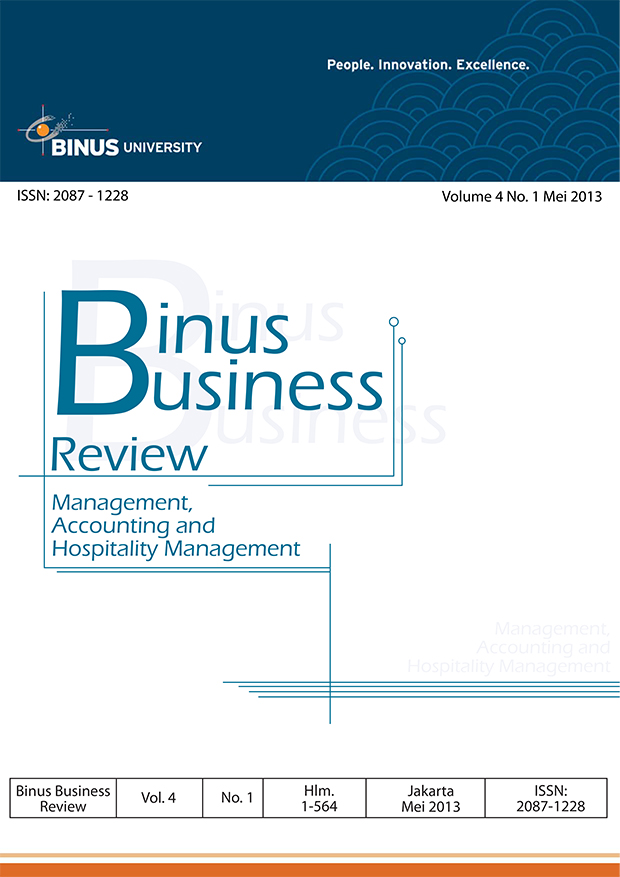Faktor-Faktor yang Memengaruhi Kepuasan Pengguna Website Kampus
DOI:
https://doi.org/10.21512/bbr.v4i1.1408Keywords:
consumer satisfaction, campus website, structural equation modellingAbstract
The benefit of internet website is not maximall unless students are satisfied with the campus website. This study proposed and tested model explaining student satisfaction when the website is used as supplementary learning tool of face to face class method. The model is integrated determinants from Media Richness Theory, Self-Determination Theory, Knowledge Based Theory and Attribution Theory, and participant charateristics cited in the research literature. Following a demonstration and using website system in Binus University website system, data were collected from 210 college students. Structural Equation Modelling provided better support for a model that hypothesized stringer effect of website charateristics on e-service quality, motivation, and culture on using internet consumer satisfaction.References
Arsidi. (2010). Literasi Informasi Siswa Perpustakaan SMA 1 Yogyakarta. Yogyakarta: Skripsi .
Cahudhury, A. (2002). E-Business and E-Commerce Infrastructure: Technologies Supporting and Business Initiative. New York: McGraw Hill.
Davis, F. D., Bagozzi, R. P., Warshaw, P. R. (1989). User Acceptance of Computer Technology: A Comparison of Two Theoretical Models. Management Science, Vol. 35: 982-1003.
Eom, S. B., & Wen, H., Joseph. (2006). Determinants Of Students’ Perceived Leearning Outcomes and Satisfaction in University Online Education: an Empirical Investigation. Decision Science Journal of Innovation, 215-235.
Grand, R. M. (1996). Toward a Knowledge-Based Theory of the Firm. Strategic Management Journal , Vol. 17: 109-122.
Hankanson, L. (2007). Creating Knowledge: the Power and Logic of Articulation. Industrial Corporate Change, Vol. 16 (1): 15-88.
Hendarti, H. (2008). Korelasi antara efektifitas Sistem Informasi KRS Online dengan Kepuasan Mahasiswa Universitas Bina Nusantara. Jurnal Piranti Warta , Vol. 11 No. 2 April, 242-257. Kegiatan Pembelajaran. Diakses dari http://www.depdiknas.go.id/Jurnal/42/sudirman.htm
Liu, C. (2000). Exploring the Factors Associated with Web Site Success in the Context Of Electronic Commerce. Information and Management, Vol. 38: 23-34.
Liu, Y. (2003). Developing Measurement Scale Interactive Website. Journal of Advertising Reseach, Vol. 43 (2): 207-16.
Maslow. (1954). A Motivation and Personality. New York: Harper & Row.
Miles, J. A. (2012). Managerial Organization Theory. Jossey-Bass. A Wiley Imprint.
Noegroho, A. (2011). Pengguna Internet di Indonesia Tahun 2009. Proceeding International Conference Social Media Culture. Yogyakarta: Universitas Atmajaya.
Ongowarsito, H. (2008). Teknologi Informasi untuk Perpustakaan: Digital Library Sebagai Keterbatasan Informasi. Jurnal Piranti Warta. 106-117.
Parasuraman, A., Berry, L. L., and Zeithmahl, A. (1990). Refinement and Reassessment of the SERQUAL Scale. Journal of Retailing, Vol. 67 (4): 420-450.
Parasuraman, A., Berry, L. L., and Zeithmahl, A. (1991). Understanding Customer Expectations of Service. Sloan Management Review (Spring): 39-48.
Peelen. (2005). Customer Relationship Managemen. England: Prentice Hall.
Peter, P. J., and Olson, J. C. (2005). Consumer Behavior: Perilaku Konsuumen dan Strategi Pemasaran. Terjemahan Damos Sihombing. Jilid 1, edisi 4. Jakarta: Erlangga.
Pituch, I., and Lee, Y. K. (2006). The Influence of System Characteristics on E-Learning Use. Computer and Education, Vol. 47: 222-244.
Riemenschneider, C.K., Harrison, D. A., and Mykytyn, P. P. (2003). Understanding IT Adoption Decision in Small Business: Integrating Current Theories. Information & Management, Vol. 40 (4): 269-285.
Rogers, E. (1983). Diffusion of Innovation. New York: Free Press.
Saba, T. (2012). Implication of E-learning Systems and Self-Efficiency on Students Outcomes: A Model Approach. Human-Centric Computing and Information Sciences.
Sardiman, A. M. (2004). Interaksi dan Motivasi Belajar Mengajar. Jakarta: Raja Grafindo Persada.
Shu-Sheng, L. (2008). Investigating Students’ Perceived Satisfaction, Behavioral Intention, and Effectiveness of E-Learning: a Case Study of the Blackboard System. Computers & Education, Vol. 51: 864-873. Diakses dari www.elsevier.com/locate/compedu.
Siahaan, S. (2001). E-Learning (Pembelajaran Elektronik) sebagai Salah Satu Alternatif
Son, J-B., Robb, T., and Charismiadji, I. (2011). Computer Literacy and Competency: a Survey of Indonesian Teachers of English as a Foreign Language. CALL-EJ, Vol. 12(1): 26-42. Diakses dari http://callej.org/journal/12-1/Son_2011.pdf.
Suryabrata. (2006). Psikologi Pendidikan. Jakarta: Raja Grafindo Persada.
Uno, H. B. (2007). Teori Motivasi dan Pengukurannya: Analisis di Bidang Pendidikan. Jakarta: Bumi Aksara.
Venkatesh, V. (2000). Determinants of Perceived Ease of Use: Integrating Control, Intrinsic Motivation, and Emotion into the Technology Acceptance Model. Information Systems Research, Vol. 11: 342-365.
Venkatesh, V., Bala, H. (2008). Technology Acceptance Model 3 and a Research Agenda on Interventions. Decision Sciences, Vol. 39 (2): 273-315.
Venkatesh, V., Morris, M. G., Davis, G. B., Davis, F. D. (2003). User Acceptance of Information Technology: Toward a Unified View. MIS Quarterly, Vol. 27 (3): 425- 478.
Zeithmahl, A., and Bitner. (1990). Delivering Quality Service: Balancing Customer Perceptions and Expectations. New York: The Free Press.
Zeithmahl, A., Berry, L. L., and Parasuraman, A. (1993). The Nature and Determinants of Customer Expectation of Service. Journal of the Academy of Marketing Science (Winter): 112.
Zinkhan, M. J. H. (2008). Determinant of Perception of interactive Website. Journal Of Marketing , Vol. 72 (2): 99-113.
Zurnali, C. (2004). Pengaruh Pelatihan dan Motivasi Terhadap Perilaku Produktif Karyawan Divisi Long Distance PT Telkom Tbk. Bandung: Tesis, Unpad.
Downloads
Published
How to Cite
Issue
Section
License
Authors who publish with this journal agree to the following terms:
a. Authors retain copyright and grant the journal right of first publication with the work simultaneously licensed under a Creative Commons Attribution License - Share Alike that allows others to share the work with an acknowledgment of the work's authorship and initial publication in this journal.
b. Authors are able to enter into separate, additional contractual arrangements for the non-exclusive distribution of the journal's published version of the work (e.g., post it to an institutional repository or publish it in a book), with an acknowledgment of its initial publication in this journal.
c. Authors are permitted and encouraged to post their work online (e.g., in institutional repositories or on their website) prior to and during the submission process, as it can lead to productive exchanges, as well as earlier and greater citation of published work.
USER RIGHTS
All articles published Open Access will be immediately and permanently free for everyone to read and download. We are continuously working with our author communities to select the best choice of license options, currently being defined for this journal as follows: Creative Commons Attribution-Share Alike (CC BY-SA)





















